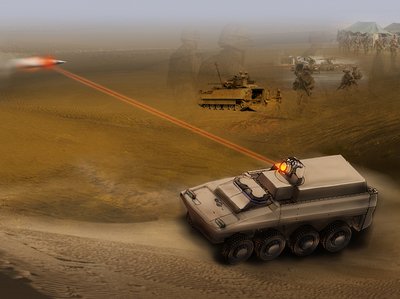
This image shows Northrop Grumman Corporation’s concept of an Future Combat Systems-class Army ground-combat armored vehicle with a solid-state laser that would be used to defeat incoming threats like mortars and rockets.
Strategy Page
The American Northrop Grumman Corporation has just opened the first ray-gun factory. Officially, the plant will build high-energy, solid-state lasers and figure out how to install them in military vehicles. The first weapon being produced is the JHPSSL (Joint High-Power Solid State Laser), a 100 kW solid-state laser. The JHPSSL is to be mounted on armored vehicles and in aircraft. JHPSSL is basically an anti-aircraft and anti-missile system. It has already demonstrated that it can destroy artillery and mortar shells, as well as rockets and cruise missiles. Israel is interested in using JHPSSL as part of its rocket defense system. Ray guns have long been a staple of science fiction, and when the first lasers appeared in the 1950s, science fiction writers just assumed that many of their ray guns were “lasers.” All this is not quite science fiction any more, mainly because it will take another decade or so before you have a hand held laser.
And a second link regarding this topic.Northrop Grumman Please continue at this link for more information. Thank you.
Northrop Grumman Corporation (NYSE:NOC) has been selected to develop “military-grade,” solid-state laser technology that is expected to pave the way for the U.S. military to incorporate high-energy laser systems across all services, including ships, manned and unmanned aircraft, and ground vehicles.

Wild Thing’s comment……
Ray guns, Rayguns, Reaguns, Reagans, Reagan = Ronaldo Maximus’ Strategic Defense Initiative = SDI = Star Wars = Democrats said NO! But now they are doing this so good.
100KW solid state LASER. Talk about your killer lightshow.

‘100KW solid state LASER’ = Not going to happen in that amount of space. It just wouldn’t fit, even without the need for a power supply. I think the reporter has their lasers confused. If the objective is a lot of power in a small space, chemical lasers are the way to go, with concentional lasers an alternative. But not solid state.
Solid state lasers are the little ones you find in laser pointers, and they dont scale well.
A vechicle-mounted laser capable of shooting down projectiles could work. It would probably cost more than the vechicle itsself though, and certinly take up most of the space within it.
Hmmmm, I know of a rally in Washington they could have done further testing of this on over this past weekend.
We have a billion test subjects(moslems)to test our laser developments on.
It’s about time they got laser technology on armor, I’ve long wished for it. I spent some time in a tank and it’s not inconcievable, sure it’s tight in the turret, the controls can be located there and the rest elsewhere on board. As for lasers, I’ve used them to punch holes in metal, then taken out of sharp focus, to reweld those same holes, that was 35 years ago and the equipment wasn’t all that large then. I can only imagine what has occured since then. If they can be mounted on aircraft they can be mounted on a Tank. Light ’em if you’ve got ’em.
Jack: The problem is both power, and optics. To get lasers to punch holes at range, you need fancy optics. And you need a tracker that can keep them pointed at exactly the same spot. Enough sheer power to not just punch a hole, but do it in the fraction of a second before a projectile hits. And that doesn’t start going crazy when people start throwing stones.
You certinly couldn’t just ‘mount’ it on a tank – the body would have to hold the laser, the turret the tracking mechanism (must be on top, to get all-round coverage), and a light-path between them means the tank would have to be built *around* the laser. It would take a completly new class of vehicle, just just retooled tanks.
Also, there might be a problem when the enemy realises that giving their missiles a coat of white paint is a semi-effective defence.
A vechicle-mounted laser would also need a power supply capable of handling a brief but very high-power pulse. Thats going to take up quite a bit of space as well. You can charge it off the engine easily, but all those capacitors are bulky.
Im not an expert, but I dont think this is at all practical for a vechicle. It may be much better suited to a stationary defence, for a base or a building. Tracking radar or optics, laser, run it off the base supply, space is much less of an object. That could work. The nessicary design would need a lot of development, but its not asking the impossible. Just a big laser, a fast turret, and some target-identification mechanism.
Actually, dont use optics. Use radar. Optics would have problems with birds. Perhaps IR to identify RPGs and rockets? Leave the details like that to the real experts.
Im not an expert either Suricou, power and optics, yes I agree. Use radar, and laser tracking, both have limitations and can be jammed but are the most reliable, IR would be my last choice.
Semiconductors have changed things radically. Cooling was and will be a problem, most tankers will welcome the air-conditioning as a refrigerated system byproduct. Capacitors have changed also, we’re not talking about Leyden jars here, capacitance is inversly proportional to plate distance and proportional to plate area, number of plates and the dielectric strength separating them. The one I worked on was very high voltage and had it’s caps set in a tank of fish oil for a dielectric and was nitrogen cooled, it was about the size of a large modern double door refrigerator, it was my baby to maintain and repair but that was light years ago. My own solid state laser puts out a 1/4″ beam. At 1000′ it’s still a 1/4″ beam, so focusing shouldn’t be an issue, tracking and traversing shouldn’t either, both have been overcome on the M1 Abrams, which sports fire on the move capability, in my day you had to stop, fix the target, fire then move before getting hit yourself. The lesser the amount of conventional weapons on board a tank the safer it is. My M48 and M60 days were interspersed with hard work and sheer terror at times, if memory serves me right there were 63 rounds of HE in the bustle with 9 more in the ready rack, that could be space open for a new weapons system. One that doesn’t detonate when spalling occurs, I don’t know of a single armor crewman that is thrilled when they hear that familiar ping of small arms on the hull, knowing that an anti-tank round might be next and we sure as hell didn’t like a fire inside the beast either. Even with the M1 Abrams, it takes time for that round to reach the target after aquisition and firing, anywhere from 1 to 3 seconds depending on the round Enough time for the enemy to fix and fire on you. SABOT is the fastest, with HEAT next and HEP rounds being the slowest, each has it’s role on the battlefield. Another thing not talked about by tankers is the misfire or hangfire, they have to be dealt with, protocol then was to drop the breech, rotate the round 90 degrees then fire it again, if that doesn’t work try firing it using the percussion method, if it still didn’t fire it had to be removed by hand from the turret and placed in the rack outside, it could still detonate out there. It’s not comfy handling an iffy round inside the turret that might detonate in your hands.
The thought of instant disablement to an enemy threat is the edge we need especially if you are the one in that iron coffin. I hope the mechanized infantry folks can get that laser edge.
I think cooling will not be a problem. This would be a pulsed laser – shoot down an incoming projectile, and there is plenty of time to cool off. Attackers could overheat the laser with sheer numbers of shells, but that would be expensive in terms of ammo, and if the attacker is a terrorist group they will have to sneak all that weaponry into range.
I still think it should be developed as a semi-portable for stationary defence though. Set up a pair of these in front of a building and configure them to shoot anything that fits the profile of a weapon heading towards the building. A much reduced threat from RPGs and such. You might even be able configure them for a low enough speed to shoot down hand-grenades thrown over a wall.